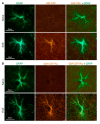Astrocytes in Multiple Sclerosis-Essential Constituents with Diverse Multifaceted Functions
- PMID: 34072790
- PMCID: PMC8198285
- DOI: 10.3390/ijms22115904
Astrocytes in Multiple Sclerosis-Essential Constituents with Diverse Multifaceted Functions
Abstract
In multiple sclerosis (MS), astrocytes respond to the inflammatory stimulation with an early robust process of morphological, transcriptional, biochemical, and functional remodeling. Recent studies utilizing novel technologies in samples from MS patients, and in an animal model of MS, experimental autoimmune encephalomyelitis (EAE), exposed the detrimental and the beneficial, in part contradictory, functions of this heterogeneous cell population. In this review, we summarize the various roles of astrocytes in recruiting immune cells to lesion sites, engendering the inflammatory loop, and inflicting tissue damage. The roles of astrocytes in suppressing excessive inflammation and promoting neuroprotection and repair processes is also discussed. The pivotal roles played by astrocytes make them an attractive therapeutic target. Improved understanding of astrocyte function and diversity, and the mechanisms by which they are regulated may lead to the development of novel approaches to selectively block astrocytic detrimental responses and/or enhance their protective properties.
Keywords: astrocyte activation; astrocytes; blood–brain barrier (BBB); experimental autoimmune encephalomyelitis (EAE); inflammation; multiple sclerosis (MS); neuroprotection; neurotrophic factors; repair processes; tissue damage.
Conflict of interest statement
The authors declare no conflict of interest.
Figures




Similar articles
-
Astrocytes in multiple sclerosis and experimental autoimmune encephalomyelitis: Star-shaped cells illuminating the darkness of CNS autoimmunity.Brain Behav Immun. 2019 Aug;80:10-24. doi: 10.1016/j.bbi.2019.05.029. Epub 2019 May 21. Brain Behav Immun. 2019. PMID: 31125711 Review.
-
Immune cell trafficking across the barriers of the central nervous system in multiple sclerosis and stroke.Biochim Biophys Acta. 2016 Mar;1862(3):461-71. doi: 10.1016/j.bbadis.2015.10.018. Epub 2015 Oct 23. Biochim Biophys Acta. 2016. PMID: 26527183 Review.
-
The Role of Astrocytes in Multiple Sclerosis.Front Immunol. 2018 Feb 19;9:217. doi: 10.3389/fimmu.2018.00217. eCollection 2018. Front Immunol. 2018. PMID: 29515568 Free PMC article. Review.
-
The Emerging Role of Zinc in the Pathogenesis of Multiple Sclerosis.Int J Mol Sci. 2017 Sep 28;18(10):2070. doi: 10.3390/ijms18102070. Int J Mol Sci. 2017. PMID: 28956834 Free PMC article. Review.
-
Astrocytes in multiple sclerosis.Mult Scler. 2016 Aug;22(9):1114-24. doi: 10.1177/1352458516643396. Epub 2016 Apr 19. Mult Scler. 2016. PMID: 27207458 Review.
Cited by
-
SIRT6 modulates lesion microenvironment in LPC induced demyelination by targeting astrocytic CHI3L1.J Neuroinflammation. 2024 Sep 28;21(1):243. doi: 10.1186/s12974-024-03241-1. J Neuroinflammation. 2024. PMID: 39342313 Free PMC article.
-
The effects of maternal anti-alpha-enolase antibody expression on the brain development in offspring.Clin Exp Immunol. 2022 Dec 15;210(2):187-198. doi: 10.1093/cei/uxac086. Clin Exp Immunol. 2022. PMID: 36149061 Free PMC article.
-
Glial cells and neurologic autoimmune disorders.Front Cell Neurosci. 2022 Oct 26;16:1028653. doi: 10.3389/fncel.2022.1028653. eCollection 2022. Front Cell Neurosci. 2022. PMID: 36385950 Free PMC article. Review.
-
The Role of Vitamin D in Neuroprotection in Multiple Sclerosis: An Update.Nutrients. 2023 Jun 30;15(13):2978. doi: 10.3390/nu15132978. Nutrients. 2023. PMID: 37447304 Free PMC article. Review.
-
Electrical stimulation of the vagus nerve ameliorates inflammation and disease activity in a rat EAE model of multiple sclerosis.Proc Natl Acad Sci U S A. 2024 Jul 9;121(28):e2322577121. doi: 10.1073/pnas.2322577121. Epub 2024 Jul 5. Proc Natl Acad Sci U S A. 2024. PMID: 38968104 Free PMC article.
References
Publication types
MeSH terms
Substances
LinkOut - more resources
Full Text Sources
Medical

